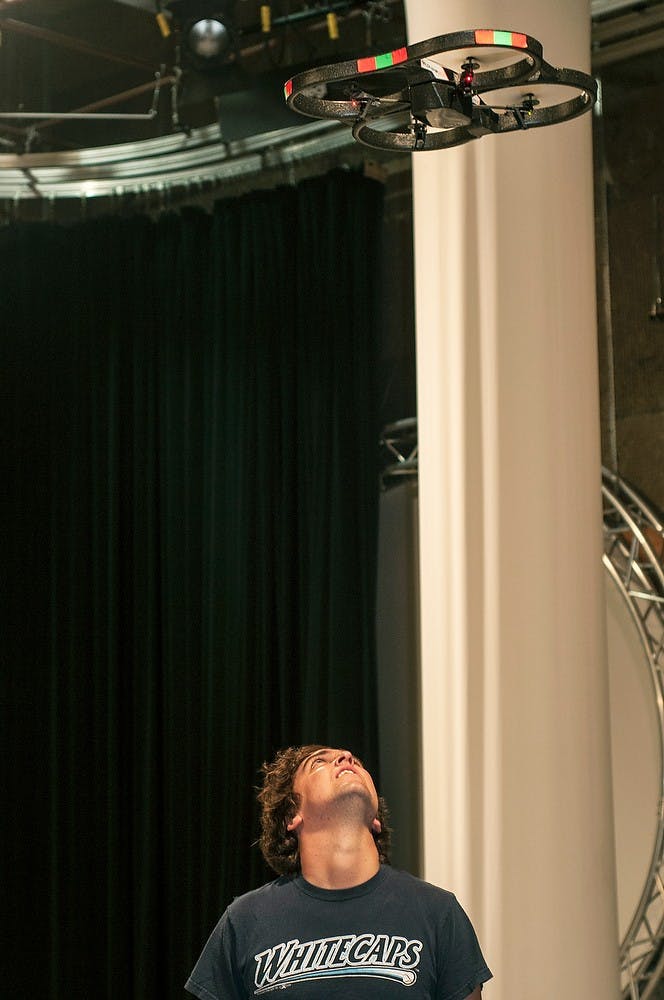New drone technology at MSU will prove useful for farmers and journalists alike.
Associate professor of geological sciences Bruno Basso will be conducting a three-to-four year experiment using a drone to monitor crop fields, advancing MSU’s roots as an agricultural school with modern-day innovations.
Other innovations include a new environmental journalism technique using drones to survey specific areas of land for visual context.
A drone is an unmanned aerial vehicle that flies without a human pilot, and often is used to record aerial footage.
The drone used for Basso’s research — remotely piloted by Basso and a few MSU graduate students — was bought by MSU in June and will be used next growing season in test crop fields — 75 total across the Midwest, Basso said.
The drone follows a preprogrammed flight plan, and its sensors can measure which areas of a crop field need fertilizer or water.
Basso said farmers then will be able to target certain areas of deficiency, saving them time and money.
“A drone can account for variations in temperature and plants’ nutrient needs,” Basso said. “It’s revolutionary for agriculture.”
Many uses
While the drones will be used for improving crops, student reporters in Journalism 472 — Lab Environmental Reporting — also are learning firsthand that drones might change the way journalists can report on the environment.
The class topic is called “News eye in the clear sky.”
Journalism professor and Great Lakes Echo Editor Dave Poulson cites a specific example last year where the drone could have been useful.
?We ran a story (in Great Lakes Echo) about the planting of fish in the Red Cedar River, but we didn’t have a good vantage point,” Poulson said. “With a drone, we could have gotten an image of those fish flying out of the river.”
Students in Poulson’s class fly the drones inside a studio, using a smartphone application, journalism senior Evan Kreager said.
But the class is not just about drones, Poulson said.
It’s about the use of remote sensing technology in environmental reporting, which includes satellite imagery, dam cams, sound-triggered wildlife cameras, mapping wildlife movements with sensors and using buoys with remote sensors.
The students don’t have Federal Aviation Administration regulatory approval to fly drones outside.
“Some students on campus are going for a certificate to fly over crop fields,” Poulson said, referring to Basso’s research. “We’d be interested, but it’s a clunky process that doesn’t lend itself to journalism — you need authorization three months in advance. The current process works for crop and other researchers, but we can’t predict where the news will be.”
Privacy concerns
Poulson also touched on the ethical implications that come with using drones.
“We’re not trying to teach MSU students to fly drones into peoples’ bedroom windows,” Poulson said. “But hypothetically, the paparazzi could get access to drones and go into the royal family’s backyard. That’s what people are thinking about in terms of legitimate concerns, but those are the type of issues we’ve addressed in the past with telephoto lenses. There should be a responsible way.”
Drones have had a bad reputation, Basso said, but MSU drones won?t violate privacy when it comes to Basso’s research.
Support student media!
Please consider donating to The State News and help fund the future of journalism.
“Traditionally, people think of drones as being used for policing,” Basso said. “This drone is strictly for agricultural use. No one needs to worry about privacy or misuse — it’s strictly being used to improve communities and ecosystems.”
Journalism graduate student Greg Monahan is taking the class, and said that it offered reporters a new perspective.
“If there was a forest fire, for example, that’s a case where a journalist wouldn’t be able to easily get content,” Monahan said. “But with a drone, you could get aerial footage without a pilot’s license. It’s less expensive and less dangerous.”
A line needs to be drawn, Poulson said, but drones can often help the public better understand important stories.
But how does the media not become too invasive?
“It’s something that needs to be discussed,” Poulson said. “But I’ve seen images of prairie fires, flooding or droughts taken with drones, and it brings the story home dramatically and it helps people understand the issue.”
Kraeger said there were a number of ways he’d use drones as an environmental reporter.
“You can use them to monitor fish populations. There’s also lots of agricultural uses,” Kraeger said. “I’m really interested in algae blooms. You can fly a drone over different bodies of water.”
The class is open to students in a variety of majors, not just journalism, and Monahan said there’s no reason to be shy about taking the class.
“The first thing that made me laugh was that it’s not as hard as you might expect,” Monahan said. “It’s not easy, but everyone in the class has piloted it, and people have crashed it. It’s durable. It’s crashed from 20 to 25 feet and it still works.”
The drones research continues MSU’s emphasis on sustainability, Basso said.
The drones also should help farmers and others save money and avoid environmental issues.
“In the past, people have always worried about production on farms,” Basso said. “This technology will increase yield, and it helps the environment because they won’t use the same amount of fertilizer — there will be less left to be lost in groundwater or emitted in the atmosphere.”
Discussion
Share and discuss “Looking to the sky” on social media.





